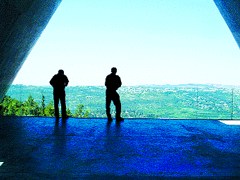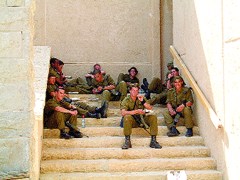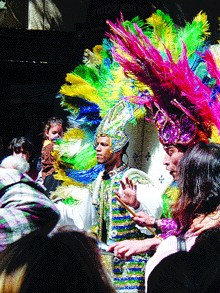 Breaking Through the Anxiety
Breaking Through the Anxiety
How one New Yorker was surprised to find Israel...
quite relaxing
Volume IV, Issue 16 | April 21 - 27,
2005
TRAVEL


Seth J. Bookey/gay city news
Yad Vashem (top l.) is Israel’s memorial of the Holocaust in Jerusalem; soldiers with guns remain an everyday, everywhere sight throughout the country; but on Purim, the nation’s festive face is in full view.
Breaking Through the Anxiety
How one New Yorker was surprised to find Israel... quite relaxing
By SETH J. BOOKEY
When I first rediscovered “the lost Israeli branch” of my great-great-uncle’s family in 1996, my desire to visit Israel—after years of wanting to but somehow never getting around to it—intensified.
But then, what happened next is what always happens... Then-Prime Minister Ehud Barak offered the Palestinians more than anyone ever had before, including re-dividing Jerusalem, and violence broke out anew. Stone throwing, protests, suicide bombings. All the things that help us say, “It’s not a good time to go to Israel.”
As luck would have it, the frequent flyer mileage that took me to Sri Lanka only worked on El Al through Tel Aviv. What kind of Diaspora Jew goes through Tel Aviv twice and doesn’t at least leave the airport for a visit?
I only had a week in Israel, and with the help of the goisrael.com Web site, and cousins I only really met through e-mail, I planned my itinerary. Or had it planned for me. Dinner with Carmit one night. Lunch with Nurit and Yoni the next day. Dinner at Hanoch’s Friday. Then, Shabbat afternoon meeting most everyone else at Ofer’s after exploring Caesaria in the morning. And that was just the first three days, and only some of my distant relations.
On Sunday, a United Bus Tour took us to Masada and the Ein Gedi spa. The next day, to Jerusalem—morning at the new museum at Yad Vashem followed by a quick tour of the Old City. And then, two nights at the kibbutz hotel at Kfar Giladi, with Hanoch behind the wheel as we drove through the Galilee and the Golan Heights. This is where Jesus is said to have walked; I was happy to have a car.
My next move—taking a public bus to Haifa—was unthinkable.
Unthinkable?
Yes, because it’s the public buses we’ve been taught to worry about. And I was worried, as half the passengers on the buses were painfully young, impossibly thin soldiers of both genders toting matching guns. Just try to find a seat without the barrel of a gun winking at you. There are guns just about everywhere, and people asking if I was carrying a gun.
Of course not, was my answer.
A visit to Masada provides a historical reinforcement of the debates stirring in Israel today. This impregnable fortress saw rebel Jews withstand the Romans for three years, until Caesar’s men built a ramp and got in, only to find everyone dead. But before that, the Jews not only survived the siege, but tossed water over the walls to taunt the Romans, to let them know that they had water to spare, to waste, in the harsh desert.
Things are not quite so desperate today, but Israel remains a fortress, walling itself in since the tortured negotiations with the Palestinians and the stubborn Jewish extremists, many of them in new settlements, are making a two-state solution difficult. Among the people I met, the desire for a peaceful solution is strong, and yet... one of my peaceful cousins had a concealed weapon with us for an entire day, something I learned to my alarm only during a security check.
Yad Vashem, the Holocaust memorial park, stands as a permanent reminder of why the Jews needed a state to begin with; the new museum charts in painful detail how the Germans denationalized its Jews, including Albert Einstein, before rounding everyone up and killing them. And along the road to Jerusalem, or at a wildlife park, or along the roads in the Golan, you will see the burned out tanks and abandoned pockmarked fortifications left by the Syrians and Jordanians in 1967. The spot where Prime Minister Yitzhak Rabin was shot has sprouted a memorial stone and flame. Even the “Island of Peace” in the Jordan River memorializes the seven girls who were gunned down by a crazed Jordanian. The girls’ names are spelled out in flowers.
Despite all of this, it didn’t take very long for me to feel completely at ease in Israel. I am still at a loss to know why. Perhaps it was because everyone I met seemed perfectly at ease and I had arrived on the Purim holiday, one of the only Jewish holidays to mandate utter giddiness. Israelis celebrate Purim by dressing up in costumes and exchanging small gifts of food, usually candy. In Tel Aviv, school groups perform on small stages while parents take their costumed children to Dizengoff Street. Some women were even getting their breasts painted on the street.
When I traveled to Masada, everyone on the tour bus, drenched in sweat from the visit, eagerly covered themselves in Dead Sea mud.
“In Israel, no one is ashamed,” my cousin Yoni explained just before we ran into his brother-in-law, the brother-in-law’s boyfriend, and their newly adopted son.
By my seventh day there, I could understand how people can live in Israel. Somehow, despite the odds, the threats, the many losses and the burden of extricating themselves from the occupied territories on the West Bank and in Gaza, most Israelis have dedicated themselves to enjoying life, and their country. Israelis travel within their own nation, which is roughly the size of New Jersey, a great deal and everyone seems to know the history of every place you might travel. Though small, Israel’s geographic and environmental diversity is astounding—from the deep valleys of the Galilee and the Golan, to the bustling, cosmopolitan world of Tel Aviv and its rising skyscrapers, to the bleak wastelands near the Dead Sea. Strangers are delighted to learn you are on your first visit to Israel.
Despite the terrorist threats, Israel is quite safe and serious crime is not a worry. Israel has more bookstores per capita, more PhDs per capita and more museums per capita than any other country in the world. Israel offers as much to the secular bookworm as it does for the extreme sport enthusiast or religious pilgrim.
Israel’s farms have made the country self-sustaining, and some produce gets exported. Vegetarians and other health-conscious eaters will appreciate the Israeli habit of salads at every meal, even at breakfast. A common habit, especially in Arab restaurants, is to offer diners a platter of a dozen vegetarian items, from pickles to hummus to lemons in tomato sauce, or your choice of any of these sorts of small side dishes, accompanied by pita bread. Often, this is a meal in and of itself
The New Israeli Shekel (NIS) runs about 4.3 to the U.S. dollar these days, but, paying in major foreign currencies is possible. Some cash registers are even set up to display prices in more than one currency. ATMs are everywhere and credit card machines abound.
In informal marketplaces, haggling does happen. By simply saying no to a 100-shekel bauble, I wound up buying it for just 70 NIS.
The Israeli tourism site, goisrael.com, offers just about everything you might want for planning your trip, from finding lodging to sketching out your itinerary.
TRAVEL



Seth J. Bookey/gay city news
Yad Vashem (top l.) is Israel’s memorial of the Holocaust in Jerusalem; soldiers with guns remain an everyday, everywhere sight throughout the country; but on Purim, the nation’s festive face is in full view.
Breaking Through the Anxiety
How one New Yorker was surprised to find Israel... quite relaxing
By SETH J. BOOKEY
When I first rediscovered “the lost Israeli branch” of my great-great-uncle’s family in 1996, my desire to visit Israel—after years of wanting to but somehow never getting around to it—intensified.
But then, what happened next is what always happens... Then-Prime Minister Ehud Barak offered the Palestinians more than anyone ever had before, including re-dividing Jerusalem, and violence broke out anew. Stone throwing, protests, suicide bombings. All the things that help us say, “It’s not a good time to go to Israel.”
As luck would have it, the frequent flyer mileage that took me to Sri Lanka only worked on El Al through Tel Aviv. What kind of Diaspora Jew goes through Tel Aviv twice and doesn’t at least leave the airport for a visit?
I only had a week in Israel, and with the help of the goisrael.com Web site, and cousins I only really met through e-mail, I planned my itinerary. Or had it planned for me. Dinner with Carmit one night. Lunch with Nurit and Yoni the next day. Dinner at Hanoch’s Friday. Then, Shabbat afternoon meeting most everyone else at Ofer’s after exploring Caesaria in the morning. And that was just the first three days, and only some of my distant relations.
On Sunday, a United Bus Tour took us to Masada and the Ein Gedi spa. The next day, to Jerusalem—morning at the new museum at Yad Vashem followed by a quick tour of the Old City. And then, two nights at the kibbutz hotel at Kfar Giladi, with Hanoch behind the wheel as we drove through the Galilee and the Golan Heights. This is where Jesus is said to have walked; I was happy to have a car.
My next move—taking a public bus to Haifa—was unthinkable.
Unthinkable?
Yes, because it’s the public buses we’ve been taught to worry about. And I was worried, as half the passengers on the buses were painfully young, impossibly thin soldiers of both genders toting matching guns. Just try to find a seat without the barrel of a gun winking at you. There are guns just about everywhere, and people asking if I was carrying a gun.
Of course not, was my answer.
A visit to Masada provides a historical reinforcement of the debates stirring in Israel today. This impregnable fortress saw rebel Jews withstand the Romans for three years, until Caesar’s men built a ramp and got in, only to find everyone dead. But before that, the Jews not only survived the siege, but tossed water over the walls to taunt the Romans, to let them know that they had water to spare, to waste, in the harsh desert.
Things are not quite so desperate today, but Israel remains a fortress, walling itself in since the tortured negotiations with the Palestinians and the stubborn Jewish extremists, many of them in new settlements, are making a two-state solution difficult. Among the people I met, the desire for a peaceful solution is strong, and yet... one of my peaceful cousins had a concealed weapon with us for an entire day, something I learned to my alarm only during a security check.
Yad Vashem, the Holocaust memorial park, stands as a permanent reminder of why the Jews needed a state to begin with; the new museum charts in painful detail how the Germans denationalized its Jews, including Albert Einstein, before rounding everyone up and killing them. And along the road to Jerusalem, or at a wildlife park, or along the roads in the Golan, you will see the burned out tanks and abandoned pockmarked fortifications left by the Syrians and Jordanians in 1967. The spot where Prime Minister Yitzhak Rabin was shot has sprouted a memorial stone and flame. Even the “Island of Peace” in the Jordan River memorializes the seven girls who were gunned down by a crazed Jordanian. The girls’ names are spelled out in flowers.
Despite all of this, it didn’t take very long for me to feel completely at ease in Israel. I am still at a loss to know why. Perhaps it was because everyone I met seemed perfectly at ease and I had arrived on the Purim holiday, one of the only Jewish holidays to mandate utter giddiness. Israelis celebrate Purim by dressing up in costumes and exchanging small gifts of food, usually candy. In Tel Aviv, school groups perform on small stages while parents take their costumed children to Dizengoff Street. Some women were even getting their breasts painted on the street.
When I traveled to Masada, everyone on the tour bus, drenched in sweat from the visit, eagerly covered themselves in Dead Sea mud.
“In Israel, no one is ashamed,” my cousin Yoni explained just before we ran into his brother-in-law, the brother-in-law’s boyfriend, and their newly adopted son.
By my seventh day there, I could understand how people can live in Israel. Somehow, despite the odds, the threats, the many losses and the burden of extricating themselves from the occupied territories on the West Bank and in Gaza, most Israelis have dedicated themselves to enjoying life, and their country. Israelis travel within their own nation, which is roughly the size of New Jersey, a great deal and everyone seems to know the history of every place you might travel. Though small, Israel’s geographic and environmental diversity is astounding—from the deep valleys of the Galilee and the Golan, to the bustling, cosmopolitan world of Tel Aviv and its rising skyscrapers, to the bleak wastelands near the Dead Sea. Strangers are delighted to learn you are on your first visit to Israel.
Despite the terrorist threats, Israel is quite safe and serious crime is not a worry. Israel has more bookstores per capita, more PhDs per capita and more museums per capita than any other country in the world. Israel offers as much to the secular bookworm as it does for the extreme sport enthusiast or religious pilgrim.
Israel’s farms have made the country self-sustaining, and some produce gets exported. Vegetarians and other health-conscious eaters will appreciate the Israeli habit of salads at every meal, even at breakfast. A common habit, especially in Arab restaurants, is to offer diners a platter of a dozen vegetarian items, from pickles to hummus to lemons in tomato sauce, or your choice of any of these sorts of small side dishes, accompanied by pita bread. Often, this is a meal in and of itself
The New Israeli Shekel (NIS) runs about 4.3 to the U.S. dollar these days, but, paying in major foreign currencies is possible. Some cash registers are even set up to display prices in more than one currency. ATMs are everywhere and credit card machines abound.
In informal marketplaces, haggling does happen. By simply saying no to a 100-shekel bauble, I wound up buying it for just 70 NIS.
The Israeli tourism site, goisrael.com, offers just about everything you might want for planning your trip, from finding lodging to sketching out your itinerary.
Posted: Thu - April 21, 2005 at 10:52 PM
Quick Links
Calendar
| Sun | Mon | Tue | Wed | Thu | Fri | Sat |
Categories
Archives
XML/RSS Feed
Statistics
Total entries in this blog:
Total entries in this category:
Published On: Jun 20, 2009 07:04 PM
Total entries in this category:
Published On: Jun 20, 2009 07:04 PM